Action Research: Covid-19 Impact on Education and Digital Tech
VerifiedAdded on 2023/01/06
|14
|3419
|62
Project
AI Summary
This action research project investigates the impact of the Covid-19 pandemic on the education sector, focusing on the shift to digital technologies as a response to school closures and social distancing measures. The research outlines the purpose and key features of action research, including its collaborative and iterative nature. It identifies the use of digital technologies as an intervention strategy and employs questionnaires to collect both qualitative and quantitative data. The data analysis involves frequency distribution analysis to interpret the impact of Covid-19 on education, the effectiveness of digital technologies, and the future implications for educational facilities. The findings indicate a significant negative impact of the pandemic, but also highlight the positive role of technology in facilitating continued learning. The project concludes with recommendations for improving educational practices in response to future disruptions and the need for continued adaptation to digital learning environments.
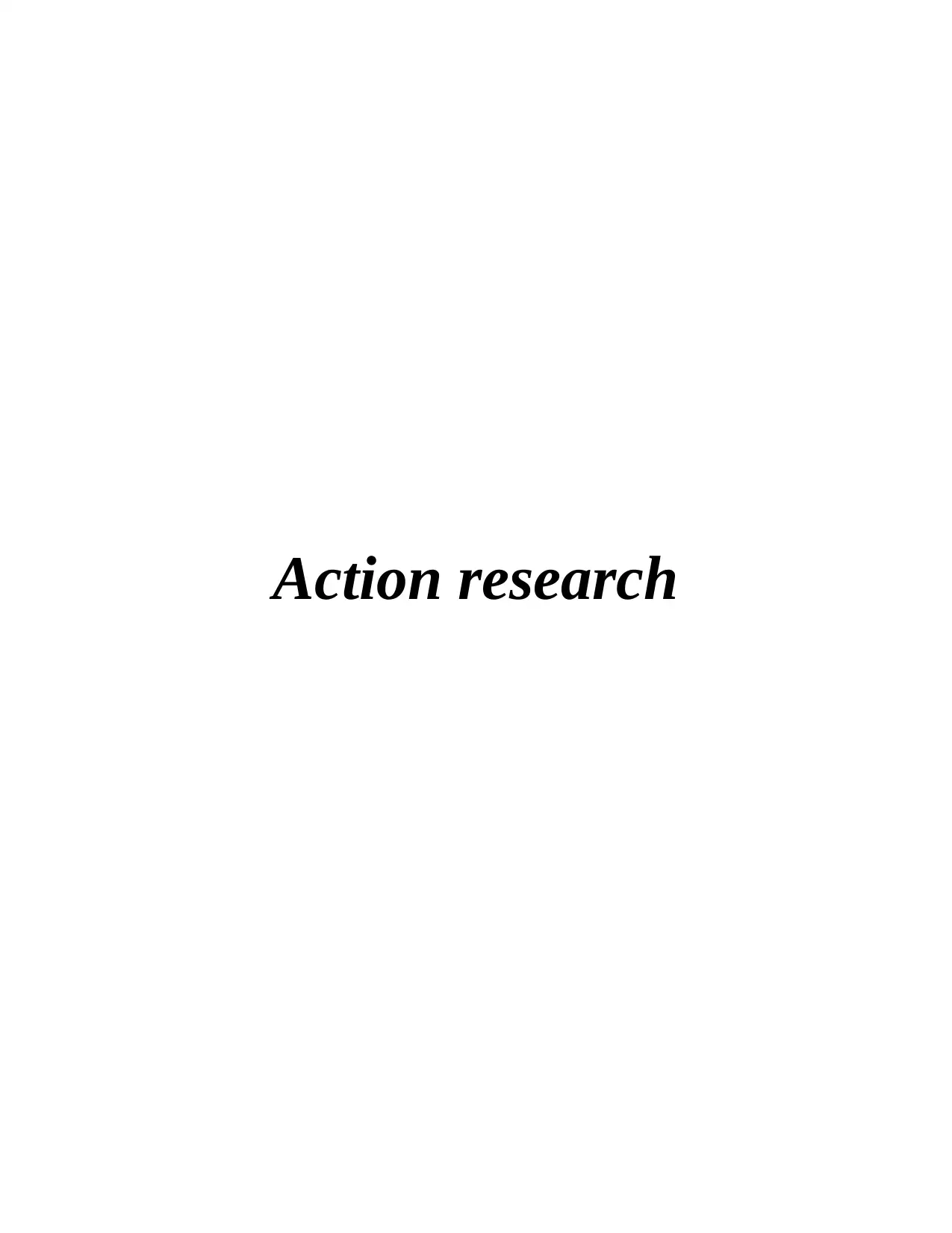
Action research
Paraphrase This Document
Need a fresh take? Get an instant paraphrase of this document with our AI Paraphraser
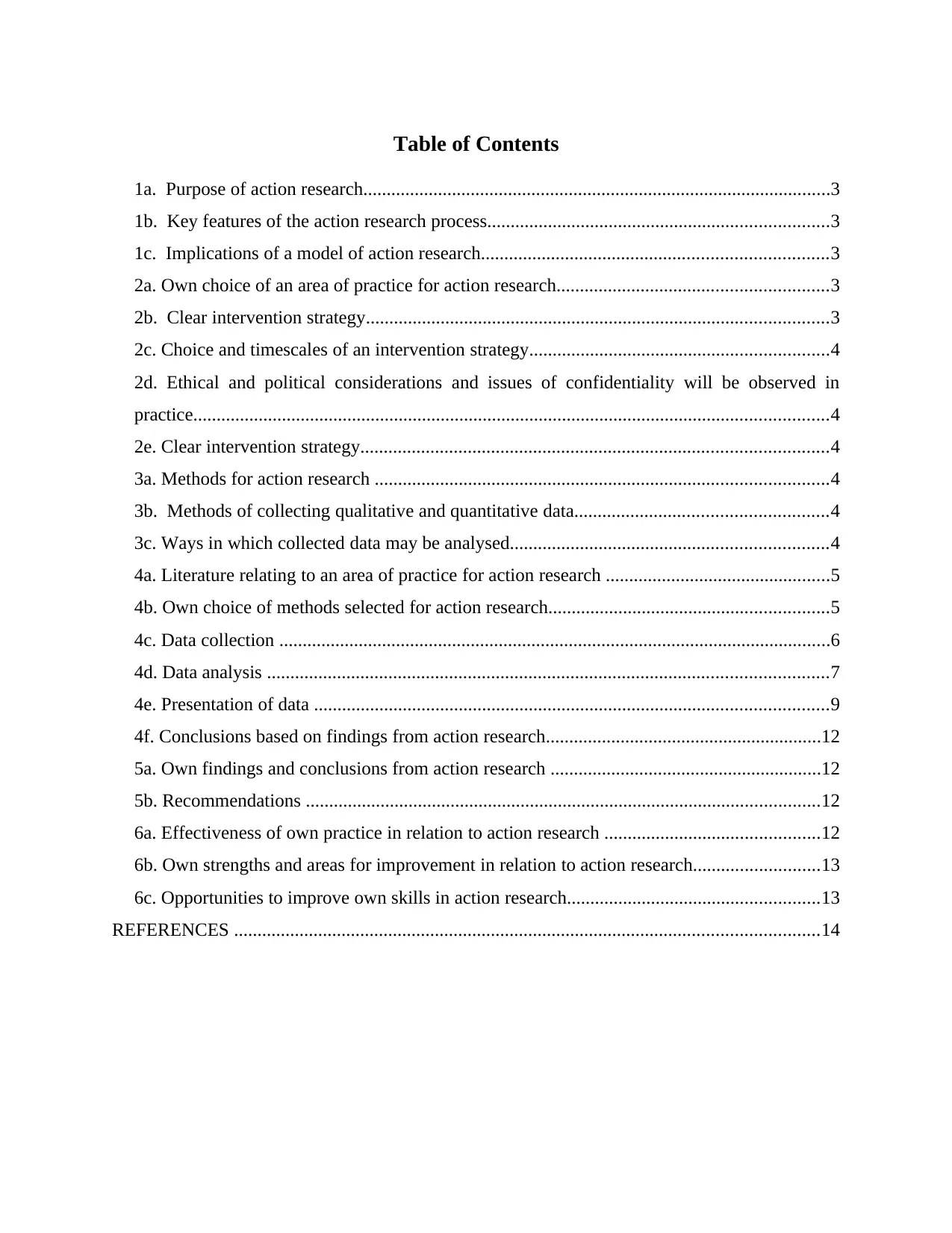
Table of Contents
1a. Purpose of action research....................................................................................................3
1b. Key features of the action research process.........................................................................3
1c. Implications of a model of action research..........................................................................3
2a. Own choice of an area of practice for action research..........................................................3
2b. Clear intervention strategy...................................................................................................3
2c. Choice and timescales of an intervention strategy................................................................4
2d. Ethical and political considerations and issues of confidentiality will be observed in
practice........................................................................................................................................4
2e. Clear intervention strategy....................................................................................................4
3a. Methods for action research .................................................................................................4
3b. Methods of collecting qualitative and quantitative data......................................................4
3c. Ways in which collected data may be analysed....................................................................4
4a. Literature relating to an area of practice for action research ................................................5
4b. Own choice of methods selected for action research............................................................5
4c. Data collection ......................................................................................................................6
4d. Data analysis ........................................................................................................................7
4e. Presentation of data ..............................................................................................................9
4f. Conclusions based on findings from action research...........................................................12
5a. Own findings and conclusions from action research ..........................................................12
5b. Recommendations ..............................................................................................................12
6a. Effectiveness of own practice in relation to action research ..............................................12
6b. Own strengths and areas for improvement in relation to action research...........................13
6c. Opportunities to improve own skills in action research......................................................13
REFERENCES .............................................................................................................................14
1a. Purpose of action research....................................................................................................3
1b. Key features of the action research process.........................................................................3
1c. Implications of a model of action research..........................................................................3
2a. Own choice of an area of practice for action research..........................................................3
2b. Clear intervention strategy...................................................................................................3
2c. Choice and timescales of an intervention strategy................................................................4
2d. Ethical and political considerations and issues of confidentiality will be observed in
practice........................................................................................................................................4
2e. Clear intervention strategy....................................................................................................4
3a. Methods for action research .................................................................................................4
3b. Methods of collecting qualitative and quantitative data......................................................4
3c. Ways in which collected data may be analysed....................................................................4
4a. Literature relating to an area of practice for action research ................................................5
4b. Own choice of methods selected for action research............................................................5
4c. Data collection ......................................................................................................................6
4d. Data analysis ........................................................................................................................7
4e. Presentation of data ..............................................................................................................9
4f. Conclusions based on findings from action research...........................................................12
5a. Own findings and conclusions from action research ..........................................................12
5b. Recommendations ..............................................................................................................12
6a. Effectiveness of own practice in relation to action research ..............................................12
6b. Own strengths and areas for improvement in relation to action research...........................13
6c. Opportunities to improve own skills in action research......................................................13
REFERENCES .............................................................................................................................14
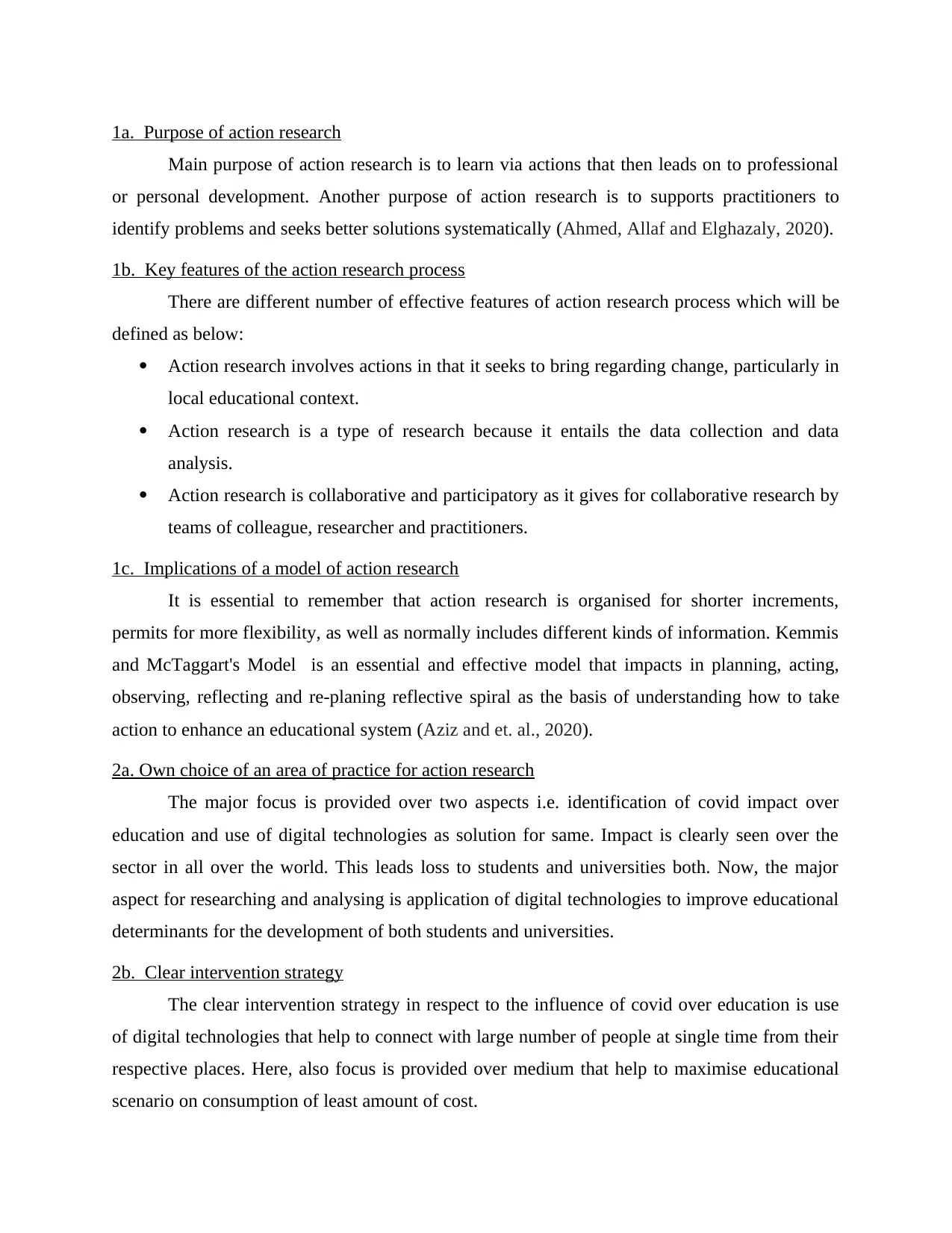
1a. Purpose of action research
Main purpose of action research is to learn via actions that then leads on to professional
or personal development. Another purpose of action research is to supports practitioners to
identify problems and seeks better solutions systematically (Ahmed, Allaf and Elghazaly, 2020).
1b. Key features of the action research process
There are different number of effective features of action research process which will be
defined as below:
Action research involves actions in that it seeks to bring regarding change, particularly in
local educational context.
Action research is a type of research because it entails the data collection and data
analysis.
Action research is collaborative and participatory as it gives for collaborative research by
teams of colleague, researcher and practitioners.
1c. Implications of a model of action research
It is essential to remember that action research is organised for shorter increments,
permits for more flexibility, as well as normally includes different kinds of information. Kemmis
and McTaggart's Model is an essential and effective model that impacts in planning, acting,
observing, reflecting and re-planing reflective spiral as the basis of understanding how to take
action to enhance an educational system (Aziz and et. al., 2020).
2a. Own choice of an area of practice for action research
The major focus is provided over two aspects i.e. identification of covid impact over
education and use of digital technologies as solution for same. Impact is clearly seen over the
sector in all over the world. This leads loss to students and universities both. Now, the major
aspect for researching and analysing is application of digital technologies to improve educational
determinants for the development of both students and universities.
2b. Clear intervention strategy
The clear intervention strategy in respect to the influence of covid over education is use
of digital technologies that help to connect with large number of people at single time from their
respective places. Here, also focus is provided over medium that help to maximise educational
scenario on consumption of least amount of cost.
Main purpose of action research is to learn via actions that then leads on to professional
or personal development. Another purpose of action research is to supports practitioners to
identify problems and seeks better solutions systematically (Ahmed, Allaf and Elghazaly, 2020).
1b. Key features of the action research process
There are different number of effective features of action research process which will be
defined as below:
Action research involves actions in that it seeks to bring regarding change, particularly in
local educational context.
Action research is a type of research because it entails the data collection and data
analysis.
Action research is collaborative and participatory as it gives for collaborative research by
teams of colleague, researcher and practitioners.
1c. Implications of a model of action research
It is essential to remember that action research is organised for shorter increments,
permits for more flexibility, as well as normally includes different kinds of information. Kemmis
and McTaggart's Model is an essential and effective model that impacts in planning, acting,
observing, reflecting and re-planing reflective spiral as the basis of understanding how to take
action to enhance an educational system (Aziz and et. al., 2020).
2a. Own choice of an area of practice for action research
The major focus is provided over two aspects i.e. identification of covid impact over
education and use of digital technologies as solution for same. Impact is clearly seen over the
sector in all over the world. This leads loss to students and universities both. Now, the major
aspect for researching and analysing is application of digital technologies to improve educational
determinants for the development of both students and universities.
2b. Clear intervention strategy
The clear intervention strategy in respect to the influence of covid over education is use
of digital technologies that help to connect with large number of people at single time from their
respective places. Here, also focus is provided over medium that help to maximise educational
scenario on consumption of least amount of cost.
⊘ This is a preview!⊘
Do you want full access?
Subscribe today to unlock all pages.

Trusted by 1+ million students worldwide
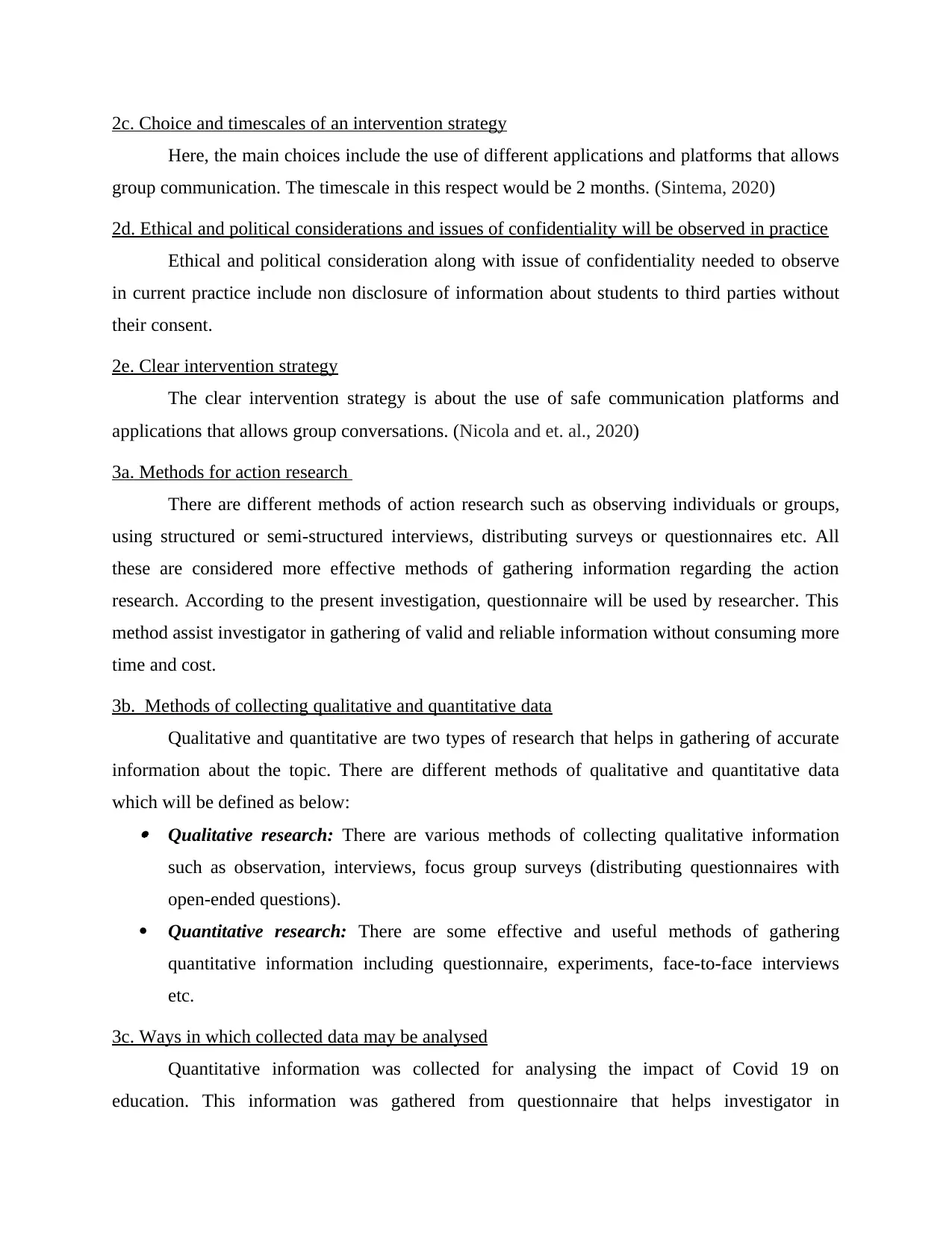
2c. Choice and timescales of an intervention strategy
Here, the main choices include the use of different applications and platforms that allows
group communication. The timescale in this respect would be 2 months. (Sintema, 2020)
2d. Ethical and political considerations and issues of confidentiality will be observed in practice
Ethical and political consideration along with issue of confidentiality needed to observe
in current practice include non disclosure of information about students to third parties without
their consent.
2e. Clear intervention strategy
The clear intervention strategy is about the use of safe communication platforms and
applications that allows group conversations. (Nicola and et. al., 2020)
3a. Methods for action research
There are different methods of action research such as observing individuals or groups,
using structured or semi-structured interviews, distributing surveys or questionnaires etc. All
these are considered more effective methods of gathering information regarding the action
research. According to the present investigation, questionnaire will be used by researcher. This
method assist investigator in gathering of valid and reliable information without consuming more
time and cost.
3b. Methods of collecting qualitative and quantitative data
Qualitative and quantitative are two types of research that helps in gathering of accurate
information about the topic. There are different methods of qualitative and quantitative data
which will be defined as below: Qualitative research: There are various methods of collecting qualitative information
such as observation, interviews, focus group surveys (distributing questionnaires with
open-ended questions).
Quantitative research: There are some effective and useful methods of gathering
quantitative information including questionnaire, experiments, face-to-face interviews
etc.
3c. Ways in which collected data may be analysed
Quantitative information was collected for analysing the impact of Covid 19 on
education. This information was gathered from questionnaire that helps investigator in
Here, the main choices include the use of different applications and platforms that allows
group communication. The timescale in this respect would be 2 months. (Sintema, 2020)
2d. Ethical and political considerations and issues of confidentiality will be observed in practice
Ethical and political consideration along with issue of confidentiality needed to observe
in current practice include non disclosure of information about students to third parties without
their consent.
2e. Clear intervention strategy
The clear intervention strategy is about the use of safe communication platforms and
applications that allows group conversations. (Nicola and et. al., 2020)
3a. Methods for action research
There are different methods of action research such as observing individuals or groups,
using structured or semi-structured interviews, distributing surveys or questionnaires etc. All
these are considered more effective methods of gathering information regarding the action
research. According to the present investigation, questionnaire will be used by researcher. This
method assist investigator in gathering of valid and reliable information without consuming more
time and cost.
3b. Methods of collecting qualitative and quantitative data
Qualitative and quantitative are two types of research that helps in gathering of accurate
information about the topic. There are different methods of qualitative and quantitative data
which will be defined as below: Qualitative research: There are various methods of collecting qualitative information
such as observation, interviews, focus group surveys (distributing questionnaires with
open-ended questions).
Quantitative research: There are some effective and useful methods of gathering
quantitative information including questionnaire, experiments, face-to-face interviews
etc.
3c. Ways in which collected data may be analysed
Quantitative information was collected for analysing the impact of Covid 19 on
education. This information was gathered from questionnaire that helps investigator in
Paraphrase This Document
Need a fresh take? Get an instant paraphrase of this document with our AI Paraphraser
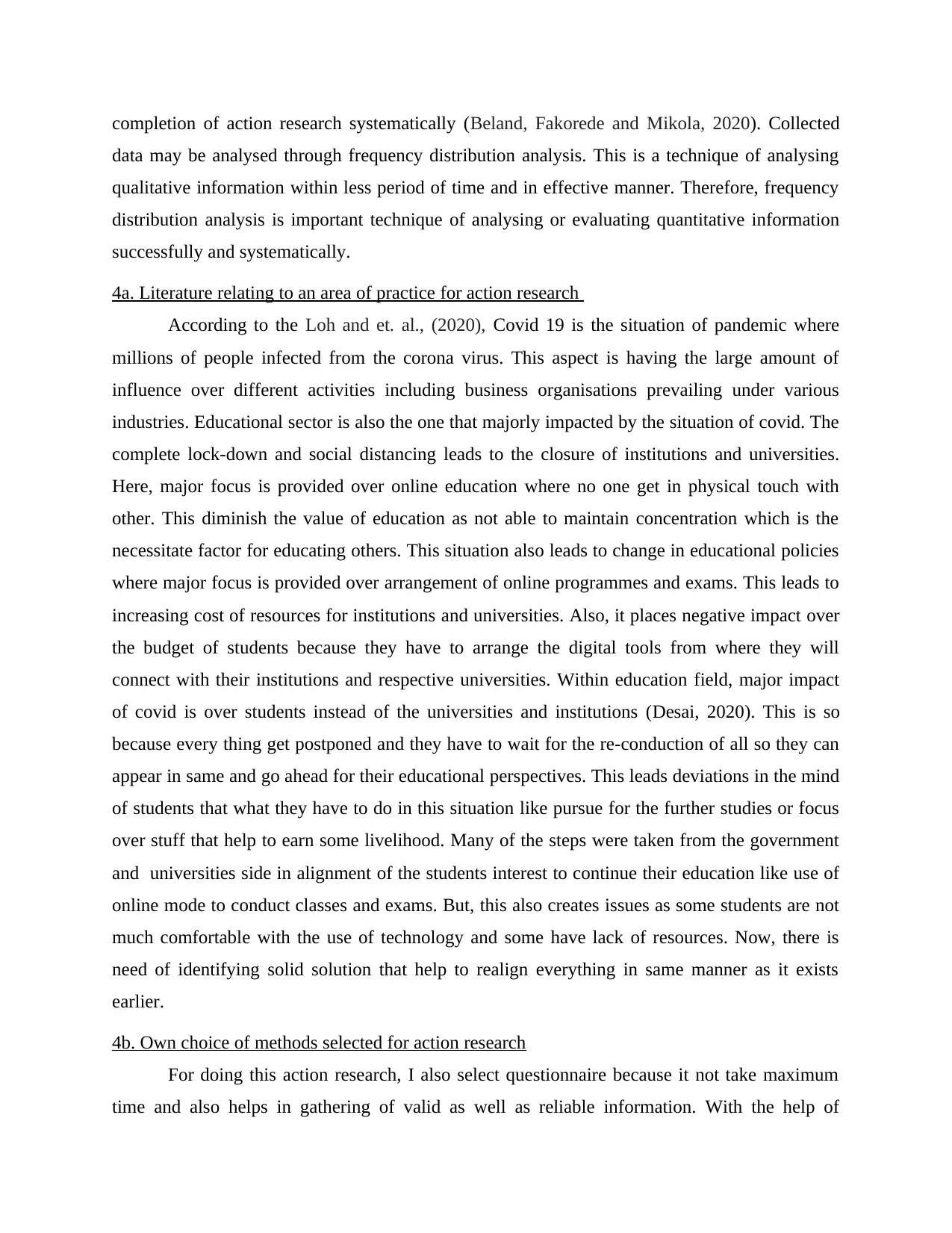
completion of action research systematically (Beland, Fakorede and Mikola, 2020). Collected
data may be analysed through frequency distribution analysis. This is a technique of analysing
qualitative information within less period of time and in effective manner. Therefore, frequency
distribution analysis is important technique of analysing or evaluating quantitative information
successfully and systematically.
4a. Literature relating to an area of practice for action research
According to the Loh and et. al., (2020), Covid 19 is the situation of pandemic where
millions of people infected from the corona virus. This aspect is having the large amount of
influence over different activities including business organisations prevailing under various
industries. Educational sector is also the one that majorly impacted by the situation of covid. The
complete lock-down and social distancing leads to the closure of institutions and universities.
Here, major focus is provided over online education where no one get in physical touch with
other. This diminish the value of education as not able to maintain concentration which is the
necessitate factor for educating others. This situation also leads to change in educational policies
where major focus is provided over arrangement of online programmes and exams. This leads to
increasing cost of resources for institutions and universities. Also, it places negative impact over
the budget of students because they have to arrange the digital tools from where they will
connect with their institutions and respective universities. Within education field, major impact
of covid is over students instead of the universities and institutions (Desai, 2020). This is so
because every thing get postponed and they have to wait for the re-conduction of all so they can
appear in same and go ahead for their educational perspectives. This leads deviations in the mind
of students that what they have to do in this situation like pursue for the further studies or focus
over stuff that help to earn some livelihood. Many of the steps were taken from the government
and universities side in alignment of the students interest to continue their education like use of
online mode to conduct classes and exams. But, this also creates issues as some students are not
much comfortable with the use of technology and some have lack of resources. Now, there is
need of identifying solid solution that help to realign everything in same manner as it exists
earlier.
4b. Own choice of methods selected for action research
For doing this action research, I also select questionnaire because it not take maximum
time and also helps in gathering of valid as well as reliable information. With the help of
data may be analysed through frequency distribution analysis. This is a technique of analysing
qualitative information within less period of time and in effective manner. Therefore, frequency
distribution analysis is important technique of analysing or evaluating quantitative information
successfully and systematically.
4a. Literature relating to an area of practice for action research
According to the Loh and et. al., (2020), Covid 19 is the situation of pandemic where
millions of people infected from the corona virus. This aspect is having the large amount of
influence over different activities including business organisations prevailing under various
industries. Educational sector is also the one that majorly impacted by the situation of covid. The
complete lock-down and social distancing leads to the closure of institutions and universities.
Here, major focus is provided over online education where no one get in physical touch with
other. This diminish the value of education as not able to maintain concentration which is the
necessitate factor for educating others. This situation also leads to change in educational policies
where major focus is provided over arrangement of online programmes and exams. This leads to
increasing cost of resources for institutions and universities. Also, it places negative impact over
the budget of students because they have to arrange the digital tools from where they will
connect with their institutions and respective universities. Within education field, major impact
of covid is over students instead of the universities and institutions (Desai, 2020). This is so
because every thing get postponed and they have to wait for the re-conduction of all so they can
appear in same and go ahead for their educational perspectives. This leads deviations in the mind
of students that what they have to do in this situation like pursue for the further studies or focus
over stuff that help to earn some livelihood. Many of the steps were taken from the government
and universities side in alignment of the students interest to continue their education like use of
online mode to conduct classes and exams. But, this also creates issues as some students are not
much comfortable with the use of technology and some have lack of resources. Now, there is
need of identifying solid solution that help to realign everything in same manner as it exists
earlier.
4b. Own choice of methods selected for action research
For doing this action research, I also select questionnaire because it not take maximum
time and also helps in gathering of valid as well as reliable information. With the help of
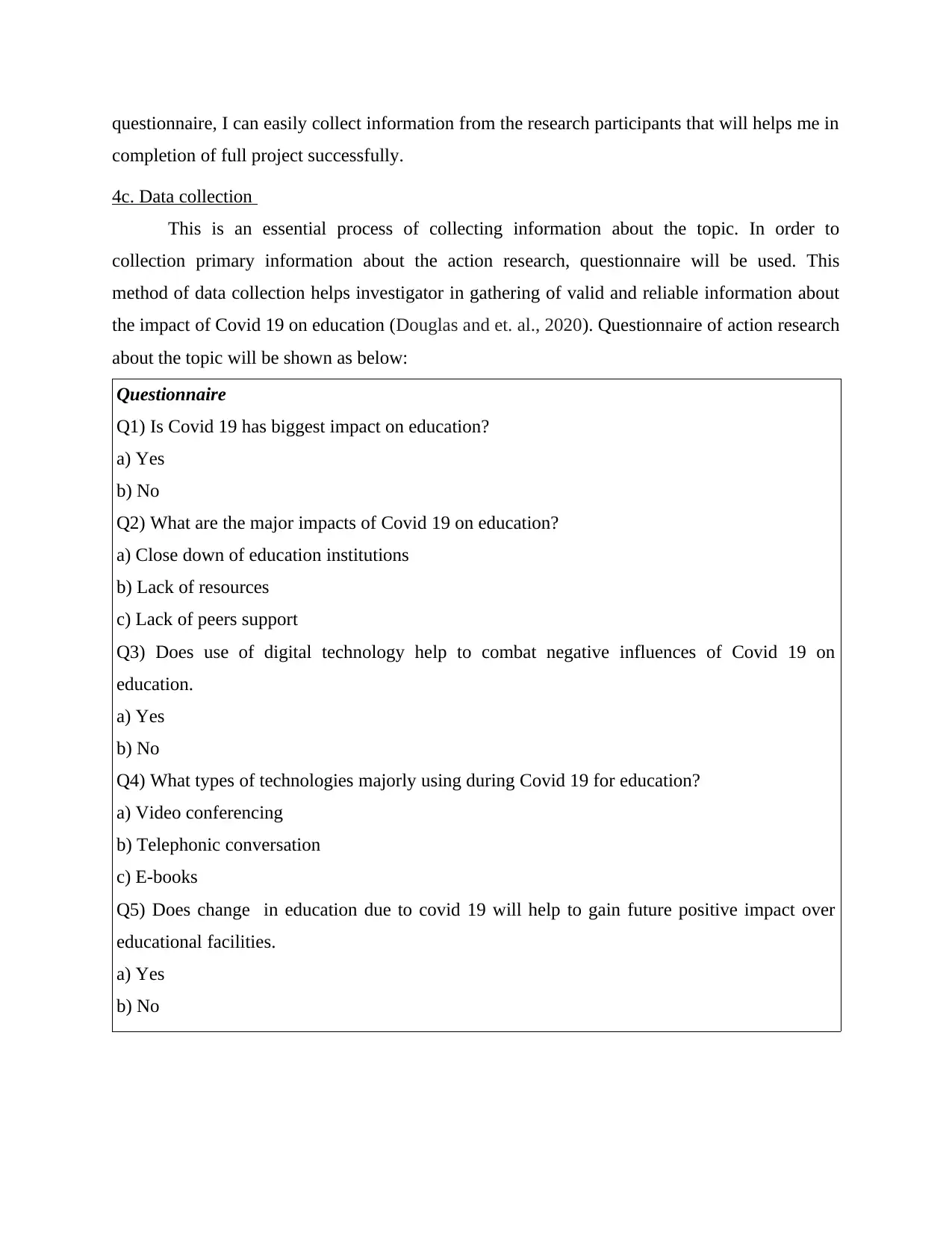
questionnaire, I can easily collect information from the research participants that will helps me in
completion of full project successfully.
4c. Data collection
This is an essential process of collecting information about the topic. In order to
collection primary information about the action research, questionnaire will be used. This
method of data collection helps investigator in gathering of valid and reliable information about
the impact of Covid 19 on education (Douglas and et. al., 2020). Questionnaire of action research
about the topic will be shown as below:
Questionnaire
Q1) Is Covid 19 has biggest impact on education?
a) Yes
b) No
Q2) What are the major impacts of Covid 19 on education?
a) Close down of education institutions
b) Lack of resources
c) Lack of peers support
Q3) Does use of digital technology help to combat negative influences of Covid 19 on
education.
a) Yes
b) No
Q4) What types of technologies majorly using during Covid 19 for education?
a) Video conferencing
b) Telephonic conversation
c) E-books
Q5) Does change in education due to covid 19 will help to gain future positive impact over
educational facilities.
a) Yes
b) No
completion of full project successfully.
4c. Data collection
This is an essential process of collecting information about the topic. In order to
collection primary information about the action research, questionnaire will be used. This
method of data collection helps investigator in gathering of valid and reliable information about
the impact of Covid 19 on education (Douglas and et. al., 2020). Questionnaire of action research
about the topic will be shown as below:
Questionnaire
Q1) Is Covid 19 has biggest impact on education?
a) Yes
b) No
Q2) What are the major impacts of Covid 19 on education?
a) Close down of education institutions
b) Lack of resources
c) Lack of peers support
Q3) Does use of digital technology help to combat negative influences of Covid 19 on
education.
a) Yes
b) No
Q4) What types of technologies majorly using during Covid 19 for education?
a) Video conferencing
b) Telephonic conversation
c) E-books
Q5) Does change in education due to covid 19 will help to gain future positive impact over
educational facilities.
a) Yes
b) No
⊘ This is a preview!⊘
Do you want full access?
Subscribe today to unlock all pages.

Trusted by 1+ million students worldwide
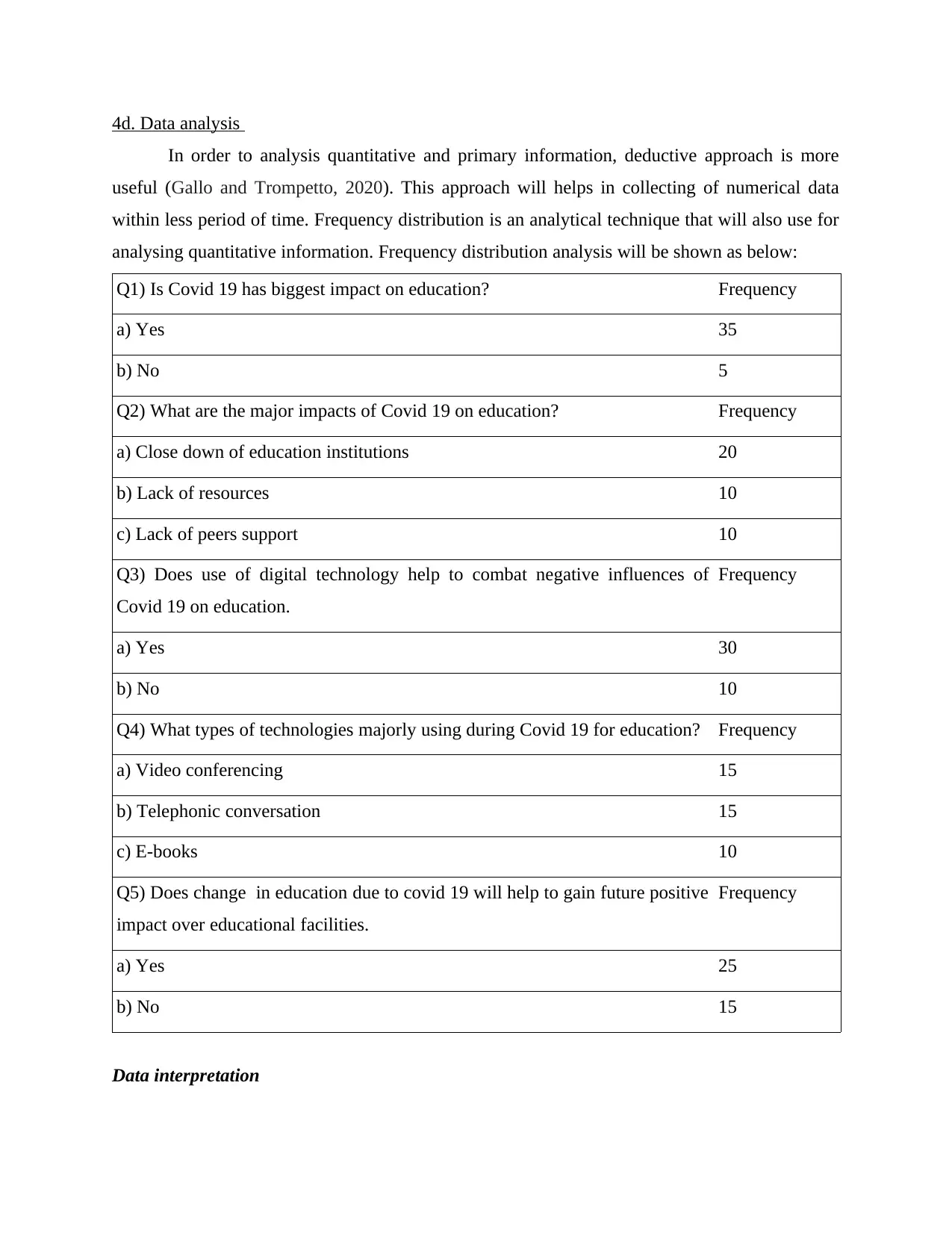
4d. Data analysis
In order to analysis quantitative and primary information, deductive approach is more
useful (Gallo and Trompetto, 2020). This approach will helps in collecting of numerical data
within less period of time. Frequency distribution is an analytical technique that will also use for
analysing quantitative information. Frequency distribution analysis will be shown as below:
Q1) Is Covid 19 has biggest impact on education? Frequency
a) Yes 35
b) No 5
Q2) What are the major impacts of Covid 19 on education? Frequency
a) Close down of education institutions 20
b) Lack of resources 10
c) Lack of peers support 10
Q3) Does use of digital technology help to combat negative influences of
Covid 19 on education.
Frequency
a) Yes 30
b) No 10
Q4) What types of technologies majorly using during Covid 19 for education? Frequency
a) Video conferencing 15
b) Telephonic conversation 15
c) E-books 10
Q5) Does change in education due to covid 19 will help to gain future positive
impact over educational facilities.
Frequency
a) Yes 25
b) No 15
Data interpretation
In order to analysis quantitative and primary information, deductive approach is more
useful (Gallo and Trompetto, 2020). This approach will helps in collecting of numerical data
within less period of time. Frequency distribution is an analytical technique that will also use for
analysing quantitative information. Frequency distribution analysis will be shown as below:
Q1) Is Covid 19 has biggest impact on education? Frequency
a) Yes 35
b) No 5
Q2) What are the major impacts of Covid 19 on education? Frequency
a) Close down of education institutions 20
b) Lack of resources 10
c) Lack of peers support 10
Q3) Does use of digital technology help to combat negative influences of
Covid 19 on education.
Frequency
a) Yes 30
b) No 10
Q4) What types of technologies majorly using during Covid 19 for education? Frequency
a) Video conferencing 15
b) Telephonic conversation 15
c) E-books 10
Q5) Does change in education due to covid 19 will help to gain future positive
impact over educational facilities.
Frequency
a) Yes 25
b) No 15
Data interpretation
Paraphrase This Document
Need a fresh take? Get an instant paraphrase of this document with our AI Paraphraser
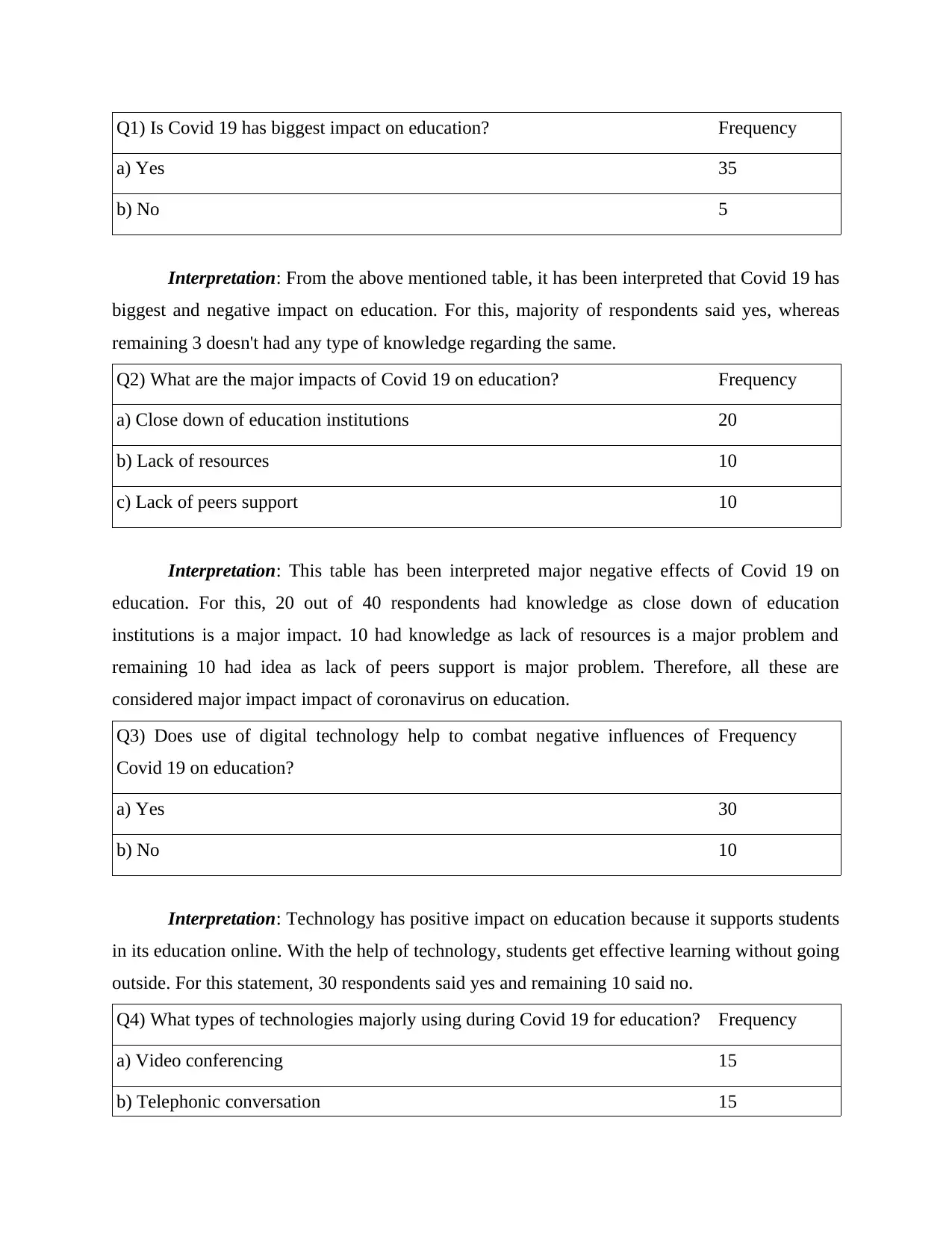
Q1) Is Covid 19 has biggest impact on education? Frequency
a) Yes 35
b) No 5
Interpretation: From the above mentioned table, it has been interpreted that Covid 19 has
biggest and negative impact on education. For this, majority of respondents said yes, whereas
remaining 3 doesn't had any type of knowledge regarding the same.
Q2) What are the major impacts of Covid 19 on education? Frequency
a) Close down of education institutions 20
b) Lack of resources 10
c) Lack of peers support 10
Interpretation: This table has been interpreted major negative effects of Covid 19 on
education. For this, 20 out of 40 respondents had knowledge as close down of education
institutions is a major impact. 10 had knowledge as lack of resources is a major problem and
remaining 10 had idea as lack of peers support is major problem. Therefore, all these are
considered major impact impact of coronavirus on education.
Q3) Does use of digital technology help to combat negative influences of
Covid 19 on education?
Frequency
a) Yes 30
b) No 10
Interpretation: Technology has positive impact on education because it supports students
in its education online. With the help of technology, students get effective learning without going
outside. For this statement, 30 respondents said yes and remaining 10 said no.
Q4) What types of technologies majorly using during Covid 19 for education? Frequency
a) Video conferencing 15
b) Telephonic conversation 15
a) Yes 35
b) No 5
Interpretation: From the above mentioned table, it has been interpreted that Covid 19 has
biggest and negative impact on education. For this, majority of respondents said yes, whereas
remaining 3 doesn't had any type of knowledge regarding the same.
Q2) What are the major impacts of Covid 19 on education? Frequency
a) Close down of education institutions 20
b) Lack of resources 10
c) Lack of peers support 10
Interpretation: This table has been interpreted major negative effects of Covid 19 on
education. For this, 20 out of 40 respondents had knowledge as close down of education
institutions is a major impact. 10 had knowledge as lack of resources is a major problem and
remaining 10 had idea as lack of peers support is major problem. Therefore, all these are
considered major impact impact of coronavirus on education.
Q3) Does use of digital technology help to combat negative influences of
Covid 19 on education?
Frequency
a) Yes 30
b) No 10
Interpretation: Technology has positive impact on education because it supports students
in its education online. With the help of technology, students get effective learning without going
outside. For this statement, 30 respondents said yes and remaining 10 said no.
Q4) What types of technologies majorly using during Covid 19 for education? Frequency
a) Video conferencing 15
b) Telephonic conversation 15
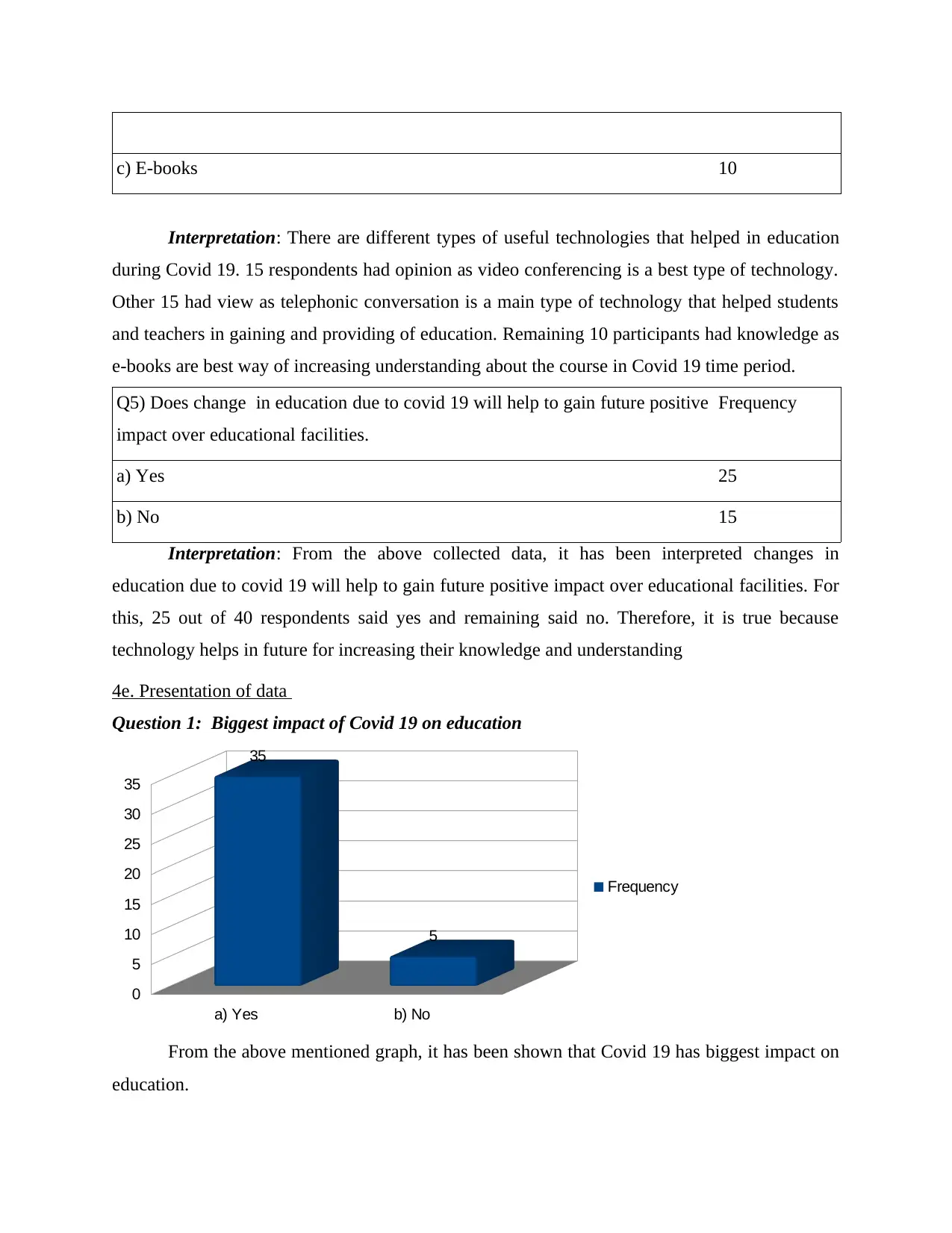
c) E-books 10
Interpretation: There are different types of useful technologies that helped in education
during Covid 19. 15 respondents had opinion as video conferencing is a best type of technology.
Other 15 had view as telephonic conversation is a main type of technology that helped students
and teachers in gaining and providing of education. Remaining 10 participants had knowledge as
e-books are best way of increasing understanding about the course in Covid 19 time period.
Q5) Does change in education due to covid 19 will help to gain future positive
impact over educational facilities.
Frequency
a) Yes 25
b) No 15
Interpretation: From the above collected data, it has been interpreted changes in
education due to covid 19 will help to gain future positive impact over educational facilities. For
this, 25 out of 40 respondents said yes and remaining said no. Therefore, it is true because
technology helps in future for increasing their knowledge and understanding
4e. Presentation of data
Question 1: Biggest impact of Covid 19 on education
a) Yes b) No
0
5
10
15
20
25
30
35
35
5
Frequency
From the above mentioned graph, it has been shown that Covid 19 has biggest impact on
education.
Interpretation: There are different types of useful technologies that helped in education
during Covid 19. 15 respondents had opinion as video conferencing is a best type of technology.
Other 15 had view as telephonic conversation is a main type of technology that helped students
and teachers in gaining and providing of education. Remaining 10 participants had knowledge as
e-books are best way of increasing understanding about the course in Covid 19 time period.
Q5) Does change in education due to covid 19 will help to gain future positive
impact over educational facilities.
Frequency
a) Yes 25
b) No 15
Interpretation: From the above collected data, it has been interpreted changes in
education due to covid 19 will help to gain future positive impact over educational facilities. For
this, 25 out of 40 respondents said yes and remaining said no. Therefore, it is true because
technology helps in future for increasing their knowledge and understanding
4e. Presentation of data
Question 1: Biggest impact of Covid 19 on education
a) Yes b) No
0
5
10
15
20
25
30
35
35
5
Frequency
From the above mentioned graph, it has been shown that Covid 19 has biggest impact on
education.
⊘ This is a preview!⊘
Do you want full access?
Subscribe today to unlock all pages.

Trusted by 1+ million students worldwide
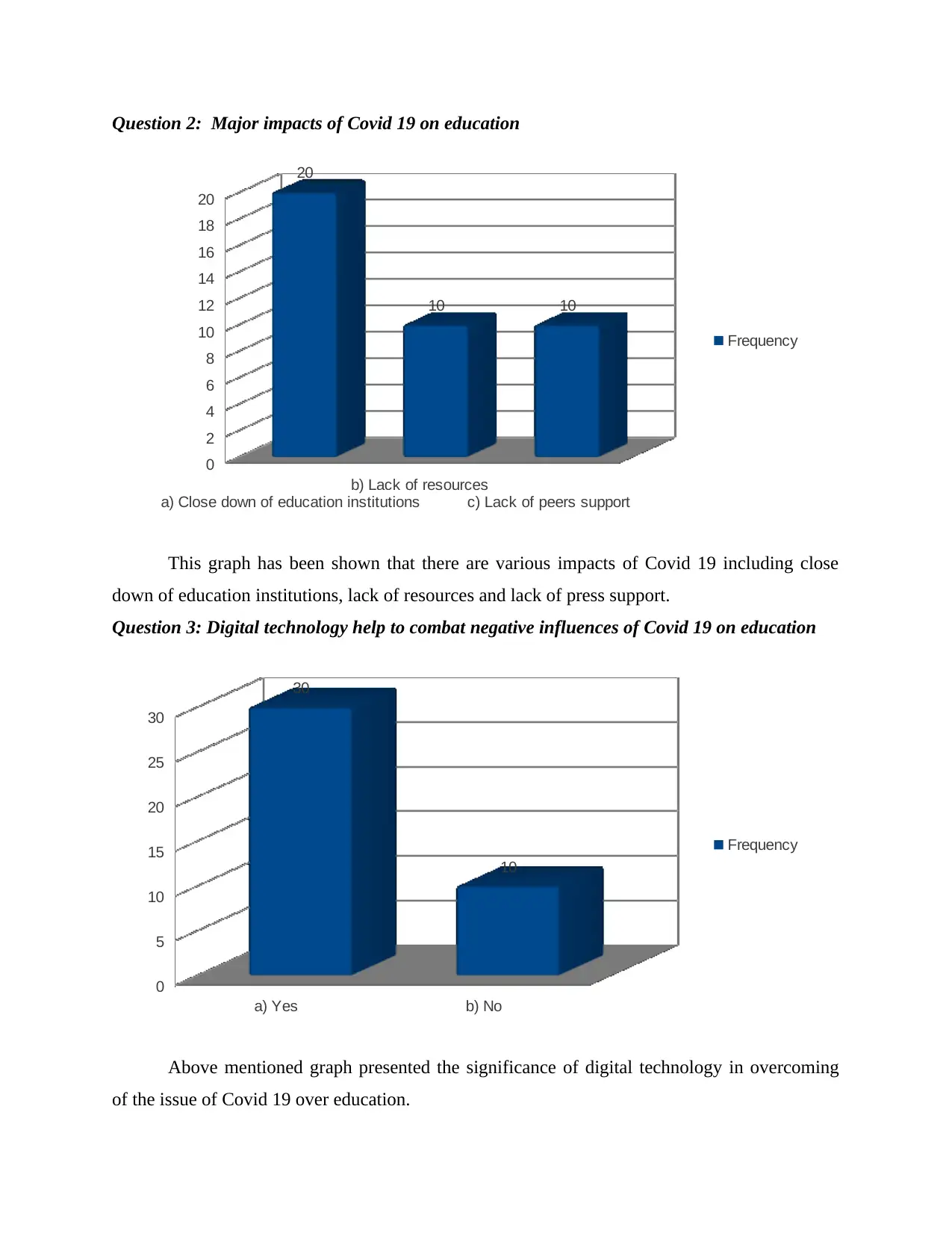
Question 2: Major impacts of Covid 19 on education
a) Close down of education institutions
b) Lack of resources
c) Lack of peers support
0
2
4
6
8
10
12
14
16
18
20
20
10 10
Frequency
This graph has been shown that there are various impacts of Covid 19 including close
down of education institutions, lack of resources and lack of press support.
Question 3: Digital technology help to combat negative influences of Covid 19 on education
a) Yes b) No
0
5
10
15
20
25
30
30
10
Frequency
Above mentioned graph presented the significance of digital technology in overcoming
of the issue of Covid 19 over education.
a) Close down of education institutions
b) Lack of resources
c) Lack of peers support
0
2
4
6
8
10
12
14
16
18
20
20
10 10
Frequency
This graph has been shown that there are various impacts of Covid 19 including close
down of education institutions, lack of resources and lack of press support.
Question 3: Digital technology help to combat negative influences of Covid 19 on education
a) Yes b) No
0
5
10
15
20
25
30
30
10
Frequency
Above mentioned graph presented the significance of digital technology in overcoming
of the issue of Covid 19 over education.
Paraphrase This Document
Need a fresh take? Get an instant paraphrase of this document with our AI Paraphraser
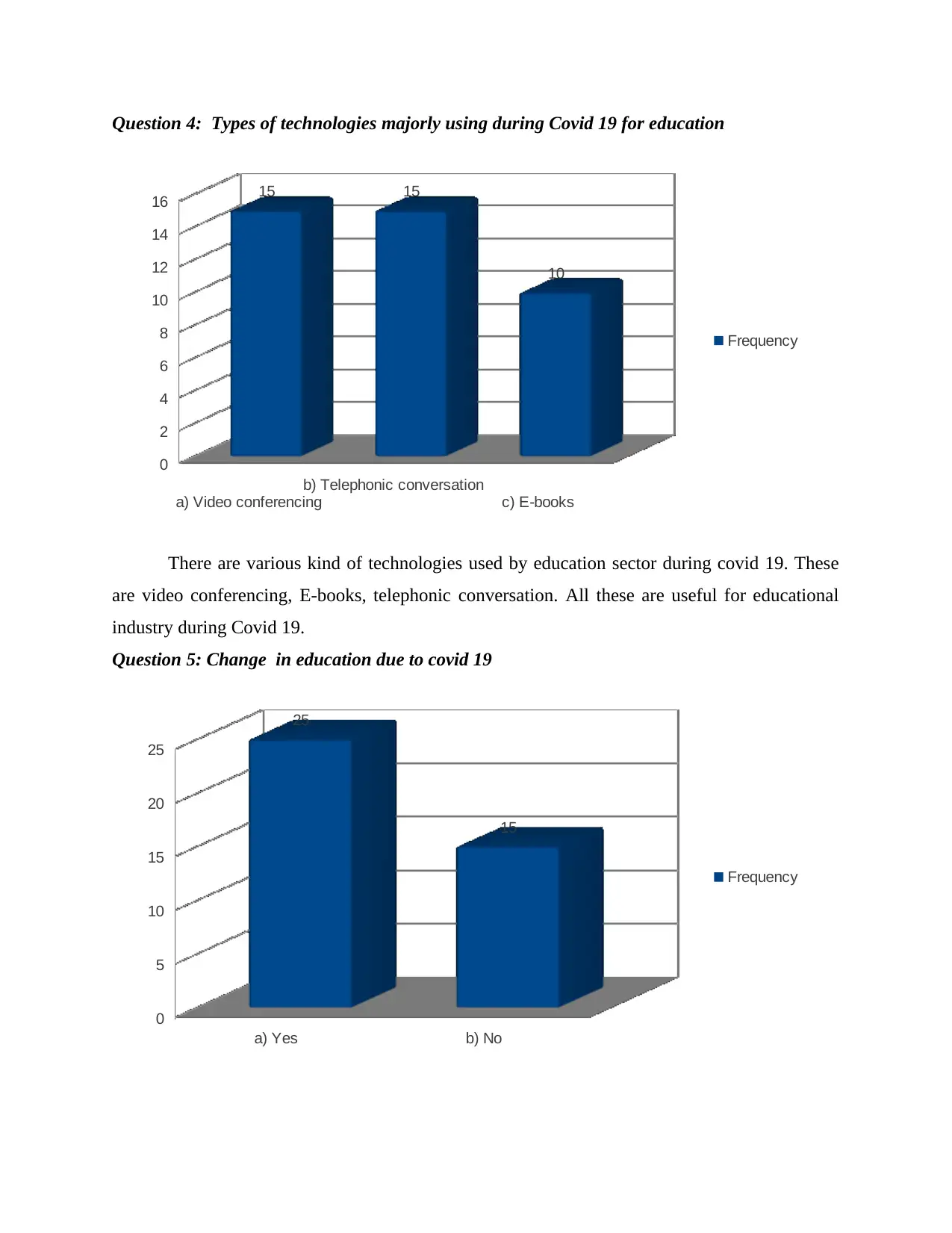
Question 4: Types of technologies majorly using during Covid 19 for education
a) Video conferencing
b) Telephonic conversation
c) E-books
0
2
4
6
8
10
12
14
16 15 15
10
Frequency
There are various kind of technologies used by education sector during covid 19. These
are video conferencing, E-books, telephonic conversation. All these are useful for educational
industry during Covid 19.
Question 5: Change in education due to covid 19
a) Yes b) No
0
5
10
15
20
25
25
15
Frequency
a) Video conferencing
b) Telephonic conversation
c) E-books
0
2
4
6
8
10
12
14
16 15 15
10
Frequency
There are various kind of technologies used by education sector during covid 19. These
are video conferencing, E-books, telephonic conversation. All these are useful for educational
industry during Covid 19.
Question 5: Change in education due to covid 19
a) Yes b) No
0
5
10
15
20
25
25
15
Frequency
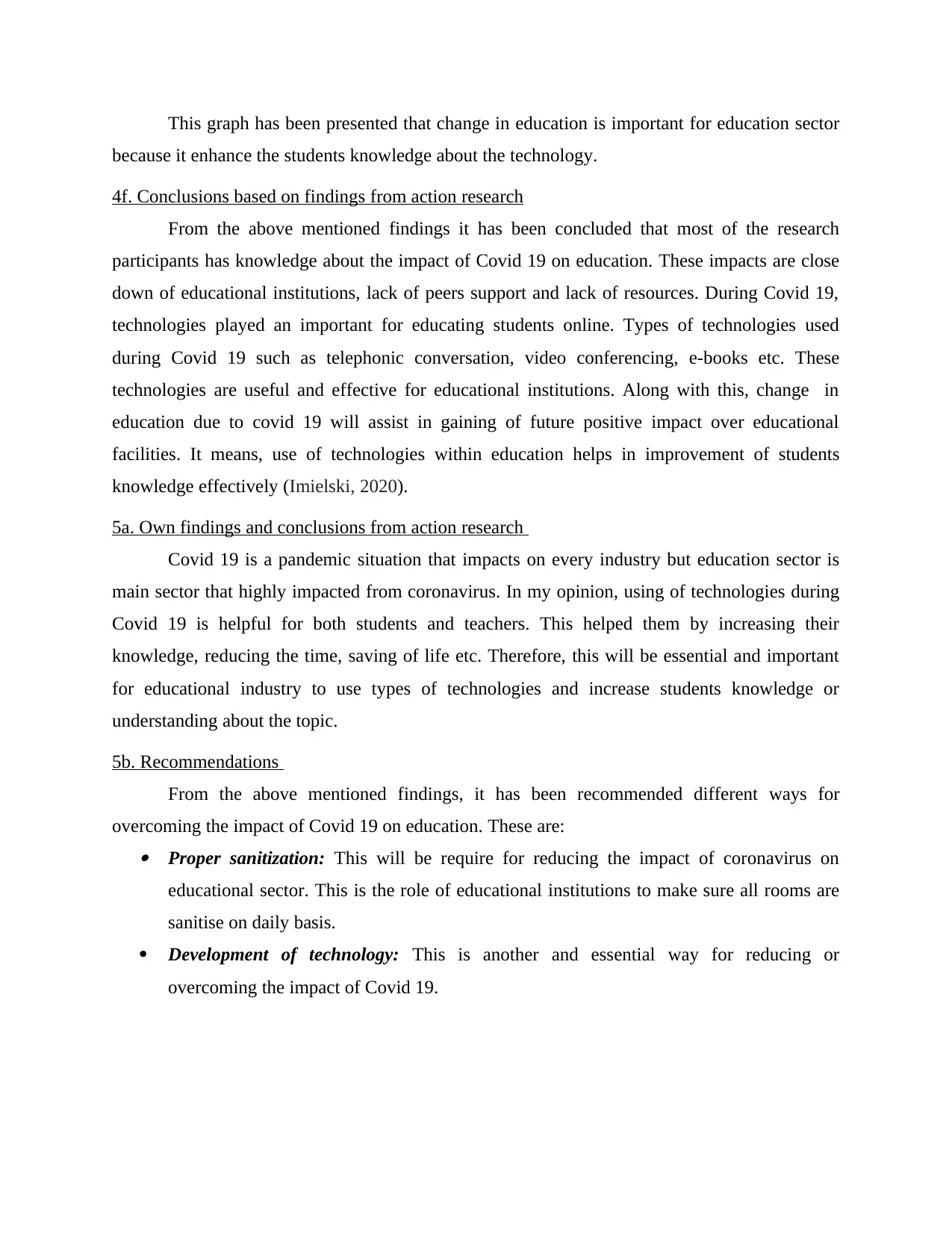
This graph has been presented that change in education is important for education sector
because it enhance the students knowledge about the technology.
4f. Conclusions based on findings from action research
From the above mentioned findings it has been concluded that most of the research
participants has knowledge about the impact of Covid 19 on education. These impacts are close
down of educational institutions, lack of peers support and lack of resources. During Covid 19,
technologies played an important for educating students online. Types of technologies used
during Covid 19 such as telephonic conversation, video conferencing, e-books etc. These
technologies are useful and effective for educational institutions. Along with this, change in
education due to covid 19 will assist in gaining of future positive impact over educational
facilities. It means, use of technologies within education helps in improvement of students
knowledge effectively (Imielski, 2020).
5a. Own findings and conclusions from action research
Covid 19 is a pandemic situation that impacts on every industry but education sector is
main sector that highly impacted from coronavirus. In my opinion, using of technologies during
Covid 19 is helpful for both students and teachers. This helped them by increasing their
knowledge, reducing the time, saving of life etc. Therefore, this will be essential and important
for educational industry to use types of technologies and increase students knowledge or
understanding about the topic.
5b. Recommendations
From the above mentioned findings, it has been recommended different ways for
overcoming the impact of Covid 19 on education. These are: Proper sanitization: This will be require for reducing the impact of coronavirus on
educational sector. This is the role of educational institutions to make sure all rooms are
sanitise on daily basis.
Development of technology: This is another and essential way for reducing or
overcoming the impact of Covid 19.
because it enhance the students knowledge about the technology.
4f. Conclusions based on findings from action research
From the above mentioned findings it has been concluded that most of the research
participants has knowledge about the impact of Covid 19 on education. These impacts are close
down of educational institutions, lack of peers support and lack of resources. During Covid 19,
technologies played an important for educating students online. Types of technologies used
during Covid 19 such as telephonic conversation, video conferencing, e-books etc. These
technologies are useful and effective for educational institutions. Along with this, change in
education due to covid 19 will assist in gaining of future positive impact over educational
facilities. It means, use of technologies within education helps in improvement of students
knowledge effectively (Imielski, 2020).
5a. Own findings and conclusions from action research
Covid 19 is a pandemic situation that impacts on every industry but education sector is
main sector that highly impacted from coronavirus. In my opinion, using of technologies during
Covid 19 is helpful for both students and teachers. This helped them by increasing their
knowledge, reducing the time, saving of life etc. Therefore, this will be essential and important
for educational industry to use types of technologies and increase students knowledge or
understanding about the topic.
5b. Recommendations
From the above mentioned findings, it has been recommended different ways for
overcoming the impact of Covid 19 on education. These are: Proper sanitization: This will be require for reducing the impact of coronavirus on
educational sector. This is the role of educational institutions to make sure all rooms are
sanitise on daily basis.
Development of technology: This is another and essential way for reducing or
overcoming the impact of Covid 19.
⊘ This is a preview!⊘
Do you want full access?
Subscribe today to unlock all pages.

Trusted by 1+ million students worldwide
1 out of 14
Related Documents
Your All-in-One AI-Powered Toolkit for Academic Success.
+13062052269
info@desklib.com
Available 24*7 on WhatsApp / Email
![[object Object]](/_next/static/media/star-bottom.7253800d.svg)
Unlock your academic potential
Copyright © 2020–2025 A2Z Services. All Rights Reserved. Developed and managed by ZUCOL.




